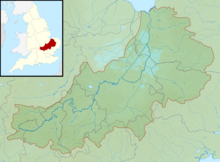
Back Great Ouse BAR Грейт Уз Bulgarian Gran Ouse Catalan River Great Ouse CEB Great Ouse Czech Грейт-Уз CV Afon Great Ouse Welsh Great Ouse Danish River Great Ouse German Great Ouse Esperanto
| River Great Ouse | |
|---|---|
 The River Great Ouse after Brownshill Staunch, near Over in Cambridgeshire | |
 Great Ouse catchment | |
 | |
| Location | |
| Country | United Kingdom |
| Constituent country | England |
| Counties | Northamptonshire, Buckinghamshire, Bedfordshire, Cambridgeshire, Norfolk |
| Physical characteristics | |
| Source | |
| • location | Syresham, West Northamptonshire, Northamptonshire, England |
| • coordinates | 52°05′33″N 01°05′35″W / 52.09250°N 1.09306°W |
| • elevation | 150 m (490 ft) |
| Mouth | The Wash |
• location | King's Lynn, United Kingdom |
• coordinates | 52°48′36″N 00°21′18″E / 52.81000°N 0.35500°E |
• elevation | 0 m (0 ft) |
| Length | 230 km (143 mi) |
| Basin size | 8,380 km2 (3,240 sq mi) |
| Discharge | |
| • location | Denver Sluice[1] Catchment area 3430 km2 |
| • average | 15.8 m3/s (560 cu ft/s)Catchment area 3430 km2 |
| Basin features | |
| Tributaries | |
| • left | Tove |
| • right | Ouzel, Cam, Lark, Little Ouse, Wissey |
The River Great Ouse (/uːz/ ooz) is a river in England, the longest of several British rivers called "Ouse". From Syresham in Northamptonshire, the Great Ouse flows through Buckinghamshire, Bedfordshire, Cambridgeshire and Norfolk to drain into the Wash and the North Sea near Kings Lynn. Authorities disagree both on the river's source and its length, with one quoting 160 mi (260 km)[2] and another 143 mi (230 km).[3] Mostly flowing north and east, it is the fifth longest river in the United Kingdom. The Great Ouse has been historically important for commercial navigation, and for draining the low-lying region through which it flows; its best-known tributary is the Cam, which runs through Cambridge. Its lower course passes through drained wetlands and fens and has been extensively modified, or channelised, to relieve flooding and provide a better route for barge traffic. The unmodified river would have changed course regularly after floods.
The name Ouse is from the Celtic or pre-Celtic *Udso-s,[4] and probably means simply "water" or slow flowing river.[5] Thus the name is a pleonasm. The lower reaches of the Great Ouse are also known as "Old West River" and "the Ely Ouse", but the entire length of the river is often referred to simply as the Ouse in informal usage (the word "Great" – which originally meant simply big or, in the case of a river, long – is used to distinguish this river from several others called the Ouse).
- ^ Ely Ouse at Denver Complex Archived 28 October 2017 at the Wayback Machine gauging station.
- ^ Clayton, Phil (2012). Headwaters: Walking to British River Sources (First ed.). London: Frances Lincoln Limited. p. 45. ISBN 9780711233638.
- ^ Owen, Susan; et al. (2005). Rivers and the British Landscape. Carnegie. ISBN 978-1-85936-120-7. Archived from the original on 20 August 2019. Retrieved 29 August 2020.
- ^ Pokorny, Julius. Indogermanisches etymologisches Wörterbuch. entry 9.
- ^ Mills, Anthony David (2003). A Dictionary of British Place Names. Oxford University Press. ISBN 0-19-852758-6.